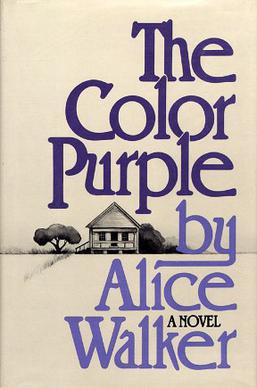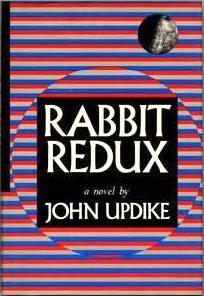
John Hoyer Updike was an American novelist, poet, short-story writer, art critic, and literary critic. One of only four writers to win the Pulitzer Prize for Fiction more than once, Updike published more than twenty novels, more than a dozen short-story collections, as well as poetry, art and literary criticism and children's books during his career.
Stephen R. Lawhead is an American writer known for his works of fantasy, science fiction, and historical fiction, particularly Celtic historical fiction. He has written over 28 novels and numerous children's and non-fiction books.

The Color Purple is a 1982 epistolary novel by American author Alice Walker that won the 1983 Pulitzer Prize for Fiction and the National Book Award for Fiction.

The World According to Garp is John Irving's fourth novel, about a man who is born out of wedlock to a feminist leader, then grows up to be a writer. Published in 1978, the book was a bestseller for several years. It was a finalist for the National Book Award for Fiction in 1979, and its first paperback edition won the award the following year.

Thomas Kennerly Wolfe Jr. was an American author and journalist widely known for his association with New Journalism, a style of news writing and journalism developed in the 1960s and 1970s that incorporated literary techniques. Much of Wolfe's work was satirical and centred on the counterculture of the 1960s and issues related to class, social status, and the lifestyles of the economic and intellectual elites of New York City.

Little, Big: or, The Fairies' Parliament is a contemporary fantasy novel by John Crowley, published in 1981. It won the World Fantasy Award in 1982.

John William Cheever was an American short story writer and novelist. He is sometimes called "the Chekhov of the suburbs". His fiction is mostly set in the Upper East Side of Manhattan; the Westchester suburbs; old New England villages based on various South Shore towns around Quincy, Massachusetts, where he was born; and Italy, especially Rome. His short stories included "The Enormous Radio", "Goodbye, My Brother", "The Five-Forty-Eight", "The Country Husband", and "The Swimmer", and he also wrote five novels: The Wapshot Chronicle , The Wapshot Scandal, Bullet Park (1969), Falconer (1977) and a novella, Oh What a Paradise It Seems (1982).

Independence Day is a 1995 novel by Richard Ford and the sequel to Ford's 1986 novel The Sportswriter. This novel is the second in what is now a five-part series, the first being The Sportswriter. It was followed by The Lay of the Land (2006), Let Me Be Frank With You (2014) and Be Mine (2023). Independence Day won the Pulitzer Prize and PEN/Faulkner Award for Fiction in 1996, becoming the first novel ever to win both awards in a single year.

Rabbit at Rest is a 1990 novel by John Updike. It is the fourth and final novel in a tetralogy, succeeding Rabbit, Run; Rabbit Redux; and Rabbit Is Rich. A related novella, Rabbit Remembered, was published in 2001. Rabbit at Rest won the Pulitzer Prize for Fiction in 1991, the second "Rabbit" novel to garner that award.
Brewer, Pennsylvania is a fictional city that serves as the major setting for American writer John Updike's "Rabbit" cycle of novels. It is the center of the only fictional universe which Updike developed across multiple works, and symbolically represents his assessment of American culture from 1959 to 1999.

Wright Marion Morris was an American novelist, photographer, and essayist. He is known for his portrayals of the people and artifacts of the Great Plains in words and pictures, as well as for experimenting with narrative forms.

Rabbit, Run is a 1960 novel by John Updike. The novel depicts three months in the life of a 26-year-old former high school basketball player named Harry "Rabbit" Angstrom, who is trapped in a loveless marriage and a boring sales job, and attempts to escape the constraints of his life. It spawned several sequels, including Rabbit Redux, Rabbit is Rich and Rabbit at Rest, as well as a related 2001 novella, Rabbit Remembered. In these novels, Updike takes a comical and retrospective look at the relentless questing life of Rabbit against the background of the major events of the latter half of the 20th century.

The Centaur is a novel by John Updike, published by Alfred A. Knopf in 1963. It won the U.S. National Book Award for Fiction. Portions of the novel first appeared in Esquire and The New Yorker.

William Keepers Maxwell Jr. was an American editor, novelist, short story writer, essayist, children's author, and memoirist. He served as a fiction editor at The New Yorker from 1936 to 1975. An editor devoted to his writers, Maxwell became a mentor and confidant to many authors.

Rabbit Redux is a 1971 novel by John Updike. It is the second book in his "Rabbit" series, beginning with Rabbit, Run and followed by Rabbit Is Rich, Rabbit At Rest, published from 1960 to 1990, and the related 2001 novella, Rabbit Remembered.

The Poorhouse Fair (1959) was the first novel by the American author John Updike. A second edition included an introduction by the author and was slightly revised.

Pigeon Feathers and Other Stories is a collection of 19 works of short fiction by John Updike. The volume is Updike's second collection of short stories, published by Alfred A. Knopf in 1962. It includes the stories "Wife-Wooing" and "A&P ", which have both been anthologized.

Melanie Benjamin – is the pen name of American writer Melanie Hauser.

Nebula Award Stories Seventeen is an anthology of award winning science fiction short works edited by Joe Haldeman. It was first published in hardcover by Holt, Rinehart and Winston in August 1983; a paperback edition was issued by Ace Books in June 1985 under the variant title Nebula Award Stories 17.

Nebula Winners Fourteen is an anthology of award winning science fiction short works edited by Frederik Pohl. It was first published in hardcover by Harper & Row in August 1980. The first British edition was published in hardcover by W. H. Allen in April 1981. Paperback editions followed from Star in the U.K. in March 1982 and Bantam Books in the U.S. in July 1982.




















